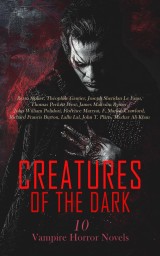Details

Creatures of the Dark: 10 Vampire Horror Novels
The Vampyre, The Lady of the Shroud, The Feast of Blood, For the Blood Is the Life|
CHF 2.00 |
|
| Verlag: | E-Artnow |
| Format: | EPUB |
| Veröffentl.: | 31.07.2024 |
| ISBN/EAN: | 4066339593022 |
| Sprache: | englisch |
| Anzahl Seiten: | 2357 |
Dieses eBook enthält ein Wasserzeichen.
Beschreibungen
This edition honors the greatest classics of the vampire literature, the original horror books that ignited the world's unending fascination with these mythical creatures of the night. This special edition includes:
"Dracula" by Bram Stoker - Bram Stoker's seminal work, crystallizes the vampire as a major figure in horror literature, introducing themes of blood, power, immortality and sexuality as well as the contrast between modernity and ancient evils.
"The Lady of the Shroud" by Bram Stoker - Another work by Bram Stoker, this novel continues to explore the themes of the supernatural and the mysterious, bridging traditional vampire lore with a more contemporary context.
"Carmilla" by Joseph Sheridan Le Fanu – this classic macabre story blends horror with themes of female sexuality, establishing a precedence for female vampires and influencing many subsequent works within the genre.
"The Vampyre" by John William Polidori - this is widely considered the first modern vampire story, establishing key characteristics of the vampire as a suave, aristocratic figure, thus paving the way for future depictions.
"Varney the Vampire; Or, the Feast of Blood" by Thomas Peckett Prest & James Malcolm Rymer - the novel involves a wide array of vampire tropes and embodies the sensationalism characteristic of Victorian-era fiction, showing the expanding narrative possibilities of the vampire myth.
"Clarimonde" by Théophile Gautier - the story presents a glamorous yet tragic image of a vampire, diverging into themes of desire and loss, emblematic of the era's fascination with the duality of beauty and horror.
"The Blood of the Vampire" by Florence Marryat - the novel echoes Gothic themes while addressing the psychological angles of vampirism and the fear of contagion, reflecting Victorian anxieties around blood and lineage.
"For the Blood Is the Life" by F. Marion Crawford - the story intertwines supernatural horror with moral considerations, showcasing how blood symbolism plays a vital role in the vampire narrative while addressing contemporary fears of degeneration.
"Dracula" by Bram Stoker - Bram Stoker's seminal work, crystallizes the vampire as a major figure in horror literature, introducing themes of blood, power, immortality and sexuality as well as the contrast between modernity and ancient evils.
"The Lady of the Shroud" by Bram Stoker - Another work by Bram Stoker, this novel continues to explore the themes of the supernatural and the mysterious, bridging traditional vampire lore with a more contemporary context.
"Carmilla" by Joseph Sheridan Le Fanu – this classic macabre story blends horror with themes of female sexuality, establishing a precedence for female vampires and influencing many subsequent works within the genre.
"The Vampyre" by John William Polidori - this is widely considered the first modern vampire story, establishing key characteristics of the vampire as a suave, aristocratic figure, thus paving the way for future depictions.
"Varney the Vampire; Or, the Feast of Blood" by Thomas Peckett Prest & James Malcolm Rymer - the novel involves a wide array of vampire tropes and embodies the sensationalism characteristic of Victorian-era fiction, showing the expanding narrative possibilities of the vampire myth.
"Clarimonde" by Théophile Gautier - the story presents a glamorous yet tragic image of a vampire, diverging into themes of desire and loss, emblematic of the era's fascination with the duality of beauty and horror.
"The Blood of the Vampire" by Florence Marryat - the novel echoes Gothic themes while addressing the psychological angles of vampirism and the fear of contagion, reflecting Victorian anxieties around blood and lineage.
"For the Blood Is the Life" by F. Marion Crawford - the story intertwines supernatural horror with moral considerations, showcasing how blood symbolism plays a vital role in the vampire narrative while addressing contemporary fears of degeneration.

















